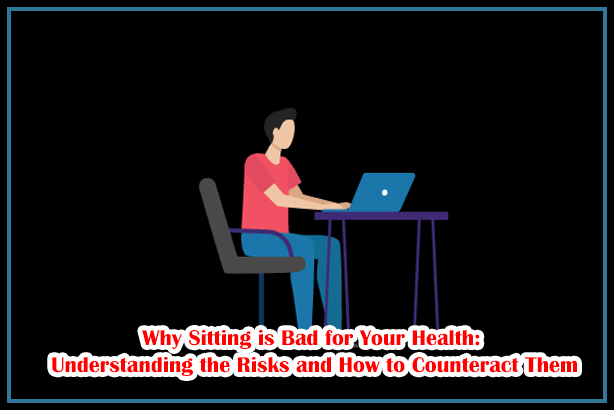
In our modern world, many of us spend a significant portion of our day sitting—whether at a desk, in a car, or on the couch. While sitting might seem like a harmless activity, research has shown that prolonged sitting can have serious negative impacts on our health. In this comprehensive article, we’ll explore why sitting is so detrimental, delve into the various health risks associated with a sedentary lifestyle, and provide practical tips to mitigate these risks. We aim to raise awareness and provide valuable insights that can help improve your well-being.
Understanding the Dangers of Prolonged Sitting
1. The Physiology of Sitting
When we sit for extended periods, our bodies undergo several physiological changes that can contribute to various health issues. One of the most significant changes is the reduction in muscle activity, which leads to decreased calorie burning and a drop in metabolic rate. This sedentary behavior also negatively impacts the circulatory system, causing blood flow to slow down and increasing the risk of blood clots.
2. Increased Risk of Cardiovascular Diseases
Numerous studies have linked prolonged sitting to an increased risk of cardiovascular diseases. Sitting for long periods can lead to higher levels of cholesterol and blood pressure, both of which are risk factors for heart disease. Additionally, a sedentary lifestyle is associated with weight gain and obesity, which further elevate the risk of developing heart-related conditions.
3. Negative Impact on Metabolic Health
Extended sitting has been shown to impair metabolic health, leading to conditions such as insulin resistance and type 2 diabetes. When we sit for too long, our muscles become less sensitive to insulin, the hormone responsible for regulating blood sugar levels. This can result in higher blood sugar levels and an increased risk of developing diabetes.
4. Musculoskeletal Problems
Sitting for long periods can cause significant strain on our musculoskeletal system, particularly the spine. Poor posture and lack of movement can lead to back pain, neck pain, and other spinal issues. Additionally, sitting can cause tightness in the hip flexors and hamstrings, contributing to muscle imbalances and discomfort.
5. Mental Health Implications
The effects of sitting are not limited to physical health; they can also impact mental well-being. Research has shown that prolonged sitting is associated with an increased risk of anxiety and depression. The lack of physical activity can lead to feelings of lethargy and a decrease in overall mood, contributing to mental health issues.
6. Increased Mortality Risk
Perhaps the most alarming finding is the link between prolonged sitting and increased mortality risk. Studies have shown that individuals who sit for extended periods are at a higher risk of premature death, regardless of their level of physical activity. This highlights the importance of minimizing sedentary behavior to improve overall longevity.
How to Counteract the Negative Effects of Sitting
While the risks associated with prolonged sitting are significant, there are several strategies you can implement to reduce these negative effects and improve your health.
1. Incorporate Regular Movement Breaks
One of the simplest and most effective ways to counteract the effects of sitting is to take regular movement breaks throughout the day. Aim to stand up, stretch, or walk around for at least 5-10 minutes every hour. Setting a timer or using a standing desk can help remind you to take these breaks and stay active.
2. Engage in Physical Activity
Regular exercise is crucial for combating the negative effects of sitting. Aim for at least 150 minutes of moderate-intensity aerobic activity or 75 minutes of vigorous-intensity activity per week, along with muscle-strengthening exercises on two or more days per week. Activities such as walking, jogging, cycling, and strength training can help improve cardiovascular health, boost metabolism, and strengthen muscles.
3. Practice Good Posture
Maintaining good posture while sitting can help reduce strain on your musculoskeletal system. Sit with your back straight, shoulders relaxed, and feet flat on the floor. Use ergonomic furniture, such as a supportive chair and an adjustable desk, to create a comfortable and healthy workspace.
4. Use Standing Desks
Standing desks or sit-stand workstations can be an excellent way to reduce the amount of time spent sitting. These desks allow you to alternate between sitting and standing throughout the day, promoting movement and reducing the risk of health issues associated with prolonged sitting.
5. Incorporate Stretching and Flexibility Exercises
Incorporating stretching and flexibility exercises into your daily routine can help alleviate muscle tightness and improve overall mobility. Focus on stretching major muscle groups, such as the hamstrings, hip flexors, and lower back. Yoga and Pilates are also great options for enhancing flexibility and promoting relaxation.
6. Stay Hydrated
Staying hydrated is essential for overall health and can also encourage regular movement. Drinking plenty of water throughout the day will naturally lead to more frequent trips to the restroom, prompting you to get up and move regularly.
7. Foster an Active Lifestyle
Incorporating more physical activity into your daily routine doesn’t have to be limited to structured exercise. Look for opportunities to be active throughout the day, such as taking the stairs instead of the elevator, walking or biking to work, or engaging in active hobbies like gardening or dancing.
Conclusion
Understanding the risks associated with prolonged sitting is crucial for taking proactive steps to protect your health. By incorporating regular movement breaks, engaging in physical activity, practicing good posture, using standing desks, stretching, staying hydrated, and fostering an active lifestyle, you can mitigate the negative effects of sitting and improve your overall well-being.
As we navigate the demands of modern life, it’s essential to prioritize our health by reducing sedentary behavior and embracing a more active lifestyle. By doing so, we can enhance our physical and mental health, reduce the risk of chronic diseases, and enjoy a longer, healthier life.